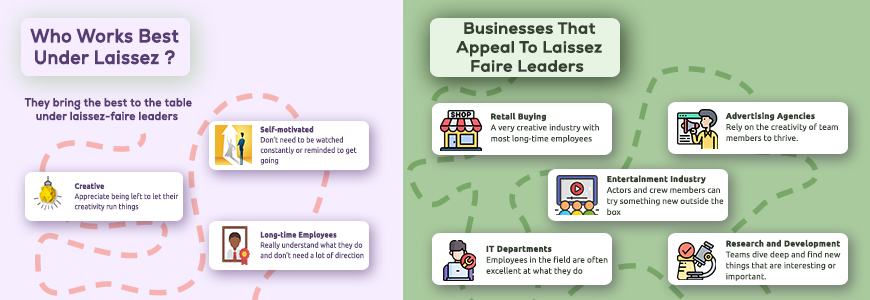In the previous piece, the advantages of Laissez-faire leadership were discussed. Now, as promised earlier here is the flipside of the coin, and some tips to tread through carefully to make a win-win for you and your team.
Cons of laissez-faire leadership
Though a lot of people succeed under laissez-faire leadership, there are some cons to this leadership approach which includes:
Challenging for beginners
In general, team members who are new to the job or company or to the workforce could find this kind of leadership challenging. New recruits need more supervision and direction more than what laissez-faire leadership provides, which gets it trickier for the beginners in getting adapted.
Confusion about who is in charge
Laissez-faire leadership every so often lead to confusion about who is accountable during certain situations. Sometimes employees with more dominant personality will go and take control, leading to flounders and problems.
Lack of structure and support
Usually, a lack of structure and help for underlings could be seen in laissez-faire leadership. This leadership approach is extremely laid-back, hence often there isn’t a set strategy, report meetings etc. This lacking makes it hard for employees to swim through.
Accountability passing
Sometimes, employees may pass the responsibility backwards to the leader stating reasons of incomprehensible demand or goal. On the contrary, it is too challenging for groups and squads to own the responsibility as it is very individual-oriented. Hence, this approach is difficult for teamwork.
Leaders can seem uninvolved.
Laissez-faire leadership can be complicated on confidence because leaders may look as if they are aloof. On the contrary, employees desire to see that they are noticed, and their effort is valued, and managers not clearly participating in a specific project can brush workers the inappropriate direction.

Ideas for laissez-faire leaders
If you’re contemplating to choose laissez-faire leadership in your business or work, it is essential to understand implementing this leadership approach properly. Here are some tips:
Observe performance
Laissez-faire leaders should consider observing their team’s performance from a distance, use breaks to discuss the observations with them, and make them understand that they are noticed. It also helps managers involve with the team and correct the course of action if required.
Address problems
Though laid back, leaders with laissez-faire approach should not really let crises stay. Focus on challenges the moment you observe them and correct, so that the team members do not get annoyed that they did not know of matters sooner.
Incentivize
Using incentives, Laissez-faire leaders can support employees making them feel inspired and thrilled about their starring role. Even though they do not micromanage, Laissez-faire leaders can observe constructive performance and reward it.
Assign
Laissez-faire leaders help ease structural disorientation by allocating tasks to particular individuals and make certain that everyone knows who is delegated with which project. This helps alleviating confusion at various levels of implementation.
Be accessible
It is important that laissez-faire leaders let their team members know that you are available when they want help. Stay willing to respond to questions, provide advice, make sure there is progress etc. All these will benefit employees and make them feel that they have got freedom and can get help once they need it.